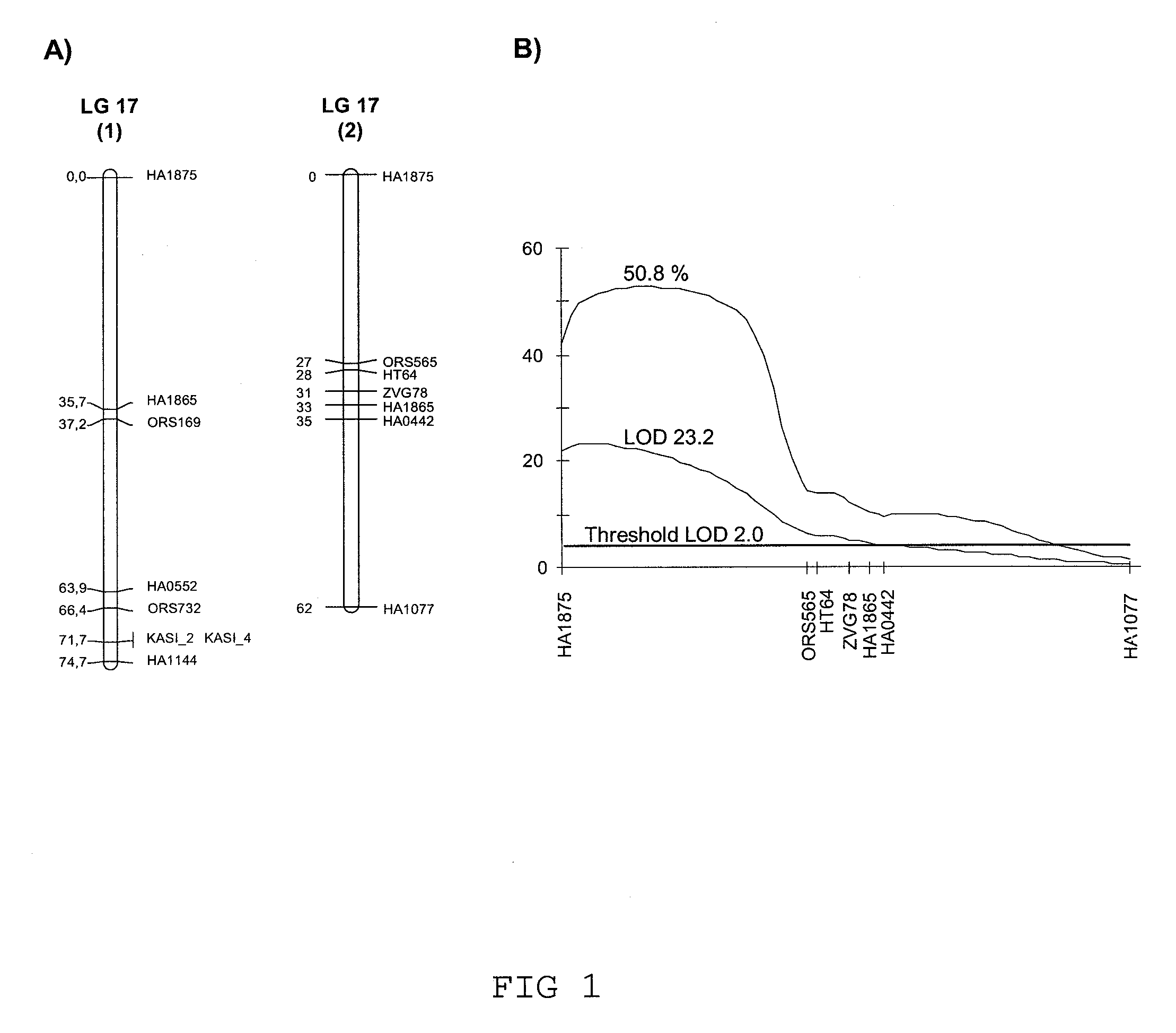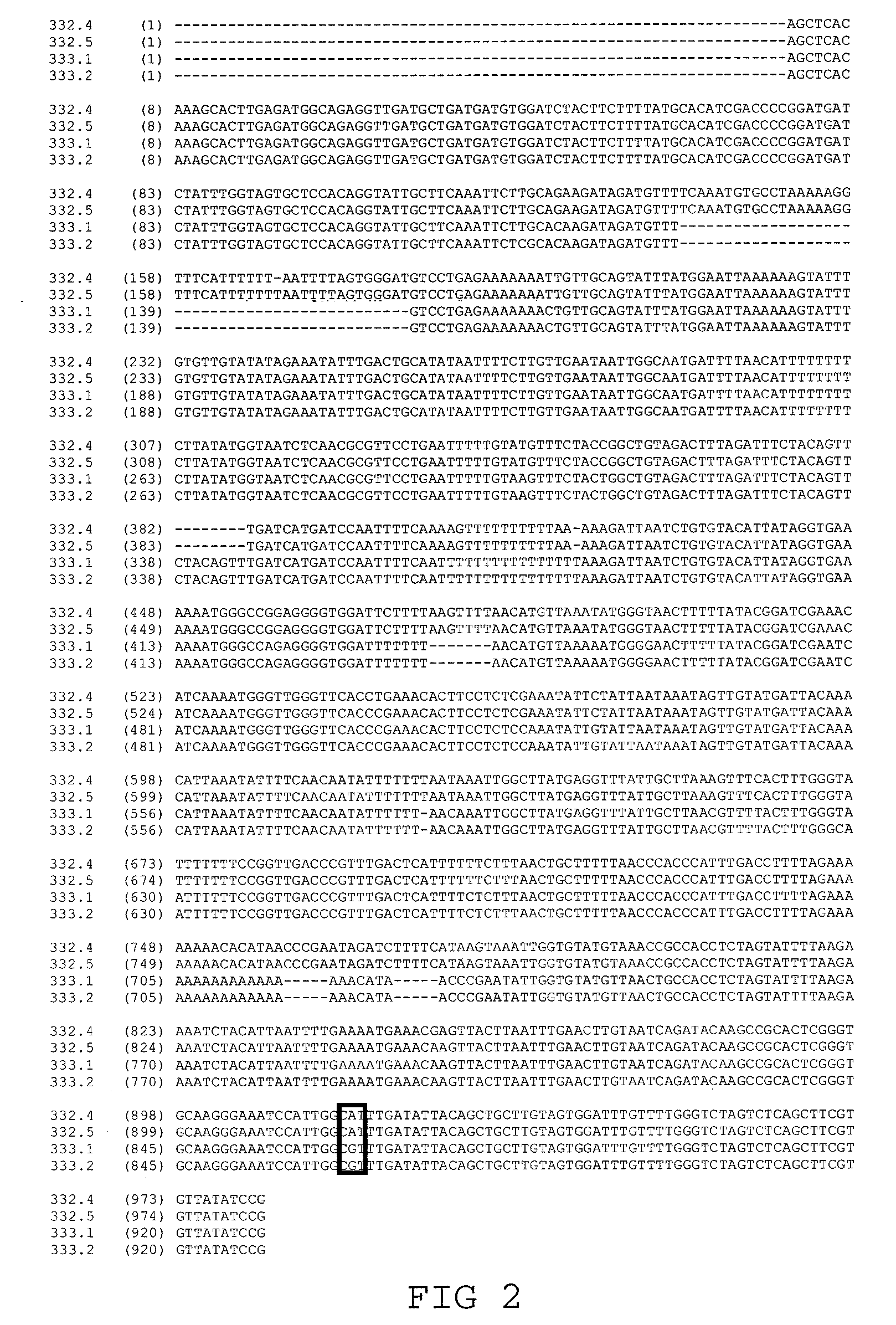Low saturated-fat sunflower and associated methods
a sunflower and low saturated fat technology, applied in the field of sunflower, can solve the problems of time-consuming process for new cultivar development, and greasy taste in the mouth, and achieve the effects of low saturated fat, enhanced nutritional quality, and high linoleic acid conten
- Summary
- Abstract
- Description
- Claims
- Application Information
AI Technical Summary
Benefits of technology
Problems solved by technology
Method used
Image
Examples
example 1
Sunflowers Producing Seeds Having Low Saturated Fat Content
[0127]Sunflower germplasm with unusually low saturate levels has been developed through normal breeding techniques. Seed oil content of sunflower cultivars are provided in Table 1.
TABLE 1TOTALC16:0 +SampleC16:0C16:1C18:0C18:1C18:2SATSC18:0H757B / LS10670B-B-2.340.090.4894.181.513.392.8217-3-23.06H757B / LS10670B-B-2.470.110.5193.622.113.422.9817-3-33.11H757B / LS10670B-B-2.240.090.5394.251.493.452.7717-3-23.04H757B / LS10670B-B-2.700.130.5093.262.243.673.217-3-02.08H757B / LS10670B-B-2.450.110.5493.621.733.682.9917-3-18.21HE06EE010716.0012.170.110.8294.291.413.632.99HE06EE010834.0022.310.110.6594.740.823.682.95HE06EE010746.0022.400.110.7293.871.033.683.12HE06EE010700.0032.480.130.5793.461.783.783.05HE06EE016032.0052.420.100.6492.861.823.823.06HE06EE016037.0052.250.080.7593.061.713.863.00HE06EE016032.0022.400.100.7093.001.723.873.09HE06EE010717.0022.440.100.8289.765.513.883.26HE06EE010695.0012.480.120.6691.933.203.883.14HE06EE010816.00...
example 2
Sunflowers Producing Seeds Having Low Saturated Fat Content and High Linoleic Acid Content
[0128]Sunflower germplasm with unusually low saturate levels has been developed through normal breeding techniques. Seed oil content of sunflower cultivars are provided in Table 2.
TABLE 2TOTALC16:0 +SampleC16:0C16:1C18:0C18:1C18:2SATSC18:0H757B / LS10670B-B-4.250.091.1337.8755.455.905.3817-3-14.01H757B / LS10670B-B-4.800.110.6839.6353.556.055.4817-3-02.18H757B / LS10670B-B-4.010.081.3738.4854.686.075.3817-3-27.12H757B / LS10670B-B-5.190.140.7335.1457.796.225.9217-3-16.02H757B / LS10670B-B-4.990.091.2517.9774.376.816.2417-3-36.22
example 3
Sunflowers Producing Seeds Having Low Saturated Fat Content
[0129]Sunflower germplasm with unusually low saturate levels has been developed through normal breeding techniques. Seed oil content of sunflower cultivars are provided in Table 3.
TABLE 3TOTALSampleC16:0C16:1C18:0C18:1C18:2SATSNuSun / No SaturateNS1982.16 / OND163R-1-052.290.050.6567.3728.193.48NS1982.82.090.080.5579.4015.993.10No Saturate / High OleicNS1982.8-031.600.030.3795.131.482.33NS1982.81.630.070.4194.811.262.48H117R[4] / / H757B / LS10670B / / / NS1.790.050.2995.300.842.571982.6-2-023-1-12-076Low Saturate / LinoleicCND117R / NS1982.8-3-065.290.070.7318.1974.436.41OI1601B[2] / / H757B / LS10670B[1] / / / 3.760.070.8034.9758.625.29NS1982.6 = B-3-04CN2343B / 4 / CN2343B[2] / / H757B / 3.130.022.0736.0356.656.23LS10670B / / / NS1982.11#1#1-3-11Low StearicNS1982.8 / OND163R-2-12-0092.750.660.2592.951.993.43H117R[4] / / H757B / LS10670B / / / 1.900.040.2795.031.002.65NS1982.6-2-023-1-12-038OID263R / NS1982.8-4-12-0023.080.120.2793.541.483.87Low PalmiticH251B[2] / IAST-4 = 1 = ...
PUM
| Property | Measurement | Unit |
|---|---|---|
| speeds | aaaaa | aaaaa |
| herbicide resistance | aaaaa | aaaaa |
| insect resistance | aaaaa | aaaaa |
Abstract
Description
Claims
Application Information
 Login to View More
Login to View More - R&D Engineer
- R&D Manager
- IP Professional
- Industry Leading Data Capabilities
- Powerful AI technology
- Patent DNA Extraction
Browse by: Latest US Patents, China's latest patents, Technical Efficacy Thesaurus, Application Domain, Technology Topic, Popular Technical Reports.
© 2024 PatSnap. All rights reserved.Legal|Privacy policy|Modern Slavery Act Transparency Statement|Sitemap|About US| Contact US: help@patsnap.com










